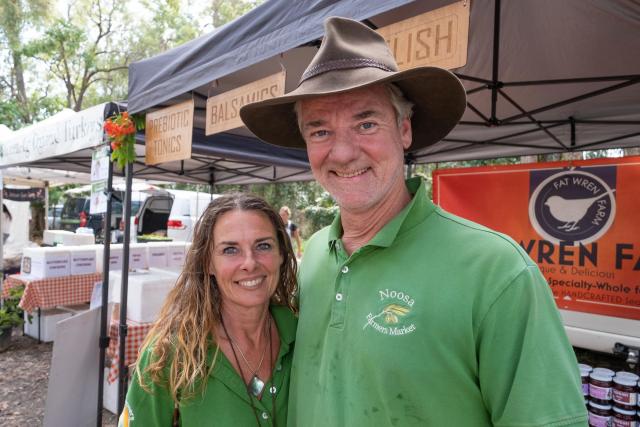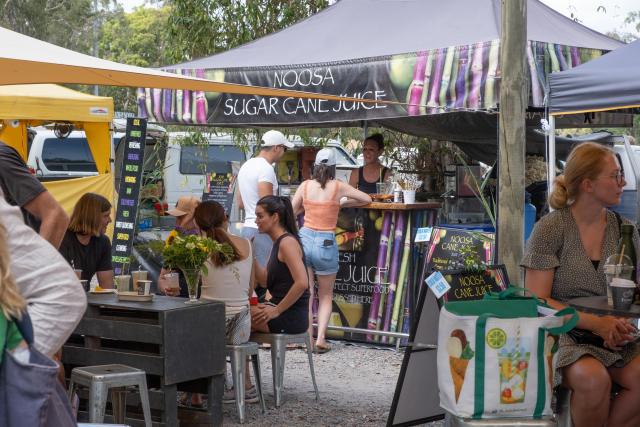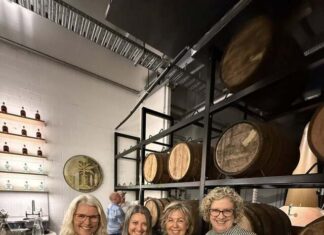When you create an event in Noosa it’s as easy to make enemies as friends, and you tend to get blamed for everything from the weather to the traffic to the tyre tracks in the car park.
But if you stand by your creation and its values, it will survive, and it might even thrive.
Celebrating the 20th anniversary of the Noosa Farmers Market on another packed Sunday morning at Rococo Oval last weekend, Shane Stanley and wife Ish could feel quietly proud that their baby has done both, evolving from a tiny operation in the corner of the Noosa Tigers’ AFL grounds in 2002 to a sprawling market of nearly 100 stalls, still on the same site, a successful family business employing eight people, a major tourist attraction and, most importantly, providing the financial lifeblood to around 3000 people in the local agricultural sector.
It hasn’t been an easy ride to get here, and along the way Shane has had his share of blues and stoushes with councils, irate shopkeepers and a few disgruntled stallholders, as well as suffering the slings and arrows of outrageous fortune in the form of droughts, floods, and a pandemic.
But the Farmers Market has barely missed a beat, and for the last eight years it’s had a Saturday twin at Kawana, while Shane has also mentored similar markets all over regional Queensland.
Born in Brisbane, Shane certainly didn’t grow up ploughing fields or herding cattle, and in his early working years as a musician and promoter he didn’t see much daylight.
But he liked the idea of the land, and felt an affinity with farmers. So when Brisbane foodie identity the late Jan Power approached him to set up a stall promoting a pub restaurant he had on his client list at her new farmers market in Brisbane, he was all in.
“So I did it and it was great, and I thought if I ever get the opportunity… I just thought Jan had a great concept,” Shane said.
As it happened, he and Ish decided to move the family to Noosa, where he was soon contacted by Wendy Birrell, who had recently bought Eats At Eumundi, had heard that Shane had some market experience and asked him to help establish a farmers market along Jan Power lines in Eumundi.
He says: “We set up in the market space on Sundays and it was quite popular, but immediately the community wanted a piece of it. The committee got too top-heavy with people who wanted to do it their way, while I wanted to do it for the farmers, so I resigned.”
But the Noosa foodie tribe had other ideas.
Next, he was approached by fabled restaurateur Leonie Palmer who asked him to consider setting up a farmers market for Noosa, and introduced him to local food gurus like Peter Howard and Jim Berardo who urged him on.
Shane says: “I was just 29 and to be honest I felt a bit intimidated, but they were very encouraging so I decided to give it a go.
“When Noosa Council told me I couldn’t do it on their land, I went looking for a private lease, and that led me to the Noosa Tigers AFL club, which had a lease from the state government. The club president and I did a handshake deal and we were in.”
The first market followed about a month later and far exceeded Shane’s modest expectations.
“We had 28 stalls, each paying $38 to be there. I’d set a budget of $1000 to promote it and run it, so we’d pretty much covered that. But what blew me away was the number of people who turned up on the back of one little ad in the paper! We had more than 500 customers that day.
“The stalls were all farmers except for a coffee guy and a bacon and eggs guy, which was to feed the farmers.
“We ended up creating a whole food court and it became a big part of what we do. The farmers were all local and mostly from the traditional farmlands in the hinterland and Mary Valley. We’ve gone a bit further afield these days, but it’s still dominated by this region.”
Although Shane didn’t know it at the time, he and Ish had established the Noosa Farmers Market just as southern Queensland was moving into the early stages of what would become known as the Millennium Drought, lasting more than five years before finally breaking with the floods of 2010.
As the drought got worse, many of the stallholders dropped out because they had no produce to sell.
“I was determined to stay true to what it was about – local produce – but I remember thinking if it doesn’t rain in the next two weeks, I’m closing down,” he recalled.
“Then, not only did it rain, but the federal government offered me significant financial assistance because they saw it as a model for farmers markets. They have disaster relief packages now but back then there was nothing, so this offer was just amazing. And it got us over the hump.”
Increasingly severe weather events have affected quite a few stallholders at different times, but Shane says that over the 20 years they’ve only lost one full weekend’s trade.
During the Covid lockdowns farmers markets were deemed essential business, but Shane says he still copped flak in the community for continuing to trade.
“My feeling was that with the rest of Noosa shut down, we had to keep going.
“Some people claimed we were a super-spreader event, but the health department had all the data and they knew that wasn’t the case. I think there were only three infections directly linked to us.
“We were outside and we were doing everything right.
“I left mask-wearing up to the individuals but we were handing them out at the gate and the police would come down to ensure that was happening.
“Yes, I copped a lot of flak over that period but I regard the fact that we didn’t let it stop us as one of our greatest achievements. My motto was don’t listen to the noise, just keep going.”
When a Sunshine Coast University study revealed than 30 per cent of the Noosa Farmers Market’s customers were coming from the southern end of the Sunshine Coast, Shane thought it made sense to open a companion market for them, so he leased land from Kawana Waters State College and opened a Saturday market.
Not only has the customer base for both markets continued to grow, but the vast majority of stallholders now attend both. Not only is this good for the Stanley family business, but it also creates a larger direct retail income stream for local farmers and producers.
“We now represent about 300 farms and from that base we have around 130 stallholders. Some of them are co-ops and some people just make arrangements to sell their neighbour’s produce as well as their own.
“The guys who sell exclusively at our markets are doing very well by retailing direct, setting their own prices rather than having Coles or Woolworths set them for you.
“But we accept all farmers, whether they sell by other means or not. We don’t take percentages from anyone’s sales, so they get the whole retail price.
“Our revenue comes from stall fees, which range from $178 to $400, depending on size and position within the market.”
Over the Covid period, the Stanleys also moved into home delivery and a click and collect program, both of which have now been integrated into the market’s new website.
It’s a good business model for the managers and the sellers, but Shane Stanley is nudging 50 now.
Will he be doing the markets for another 20 years?
“Never say never, but I don’t plan that far ahead.”










